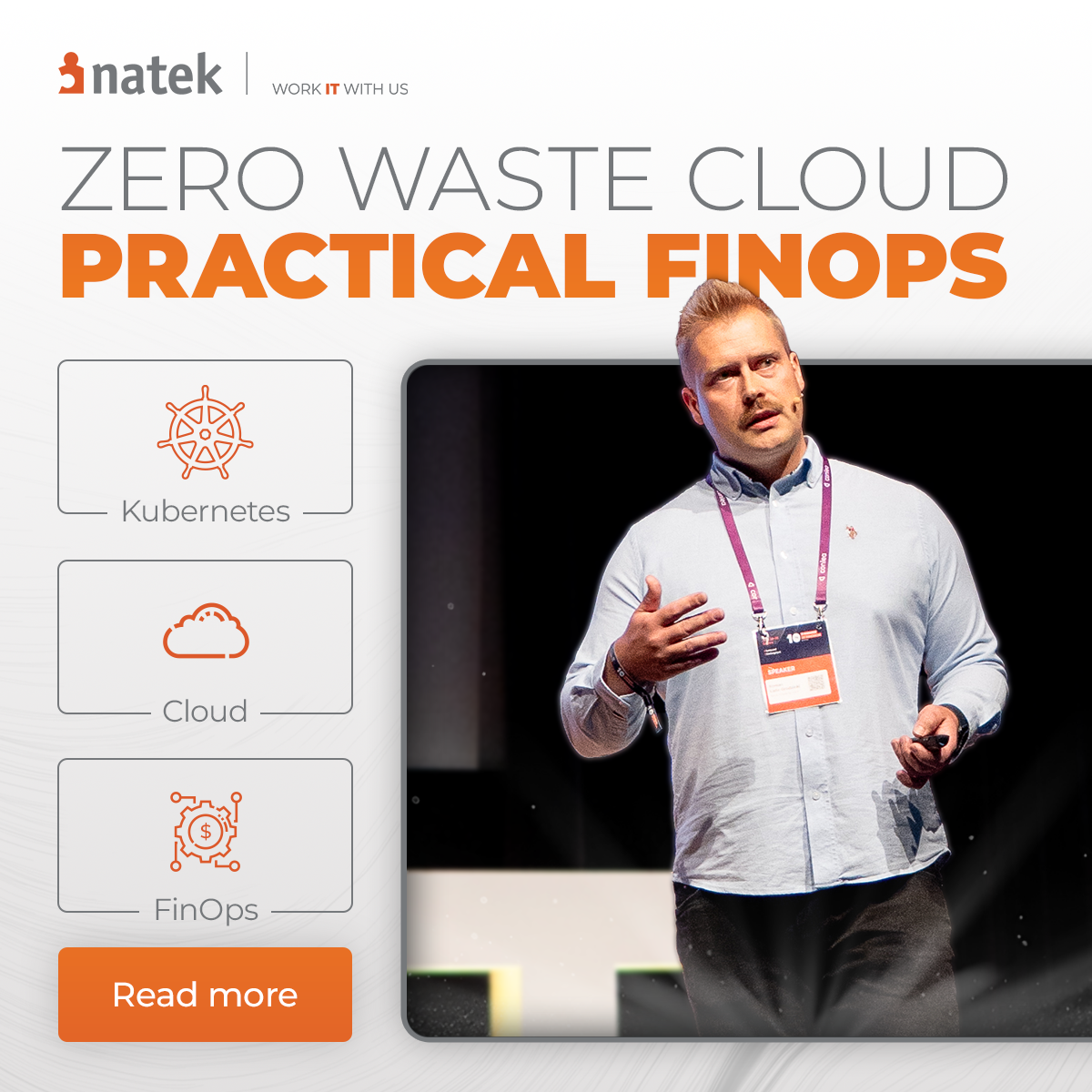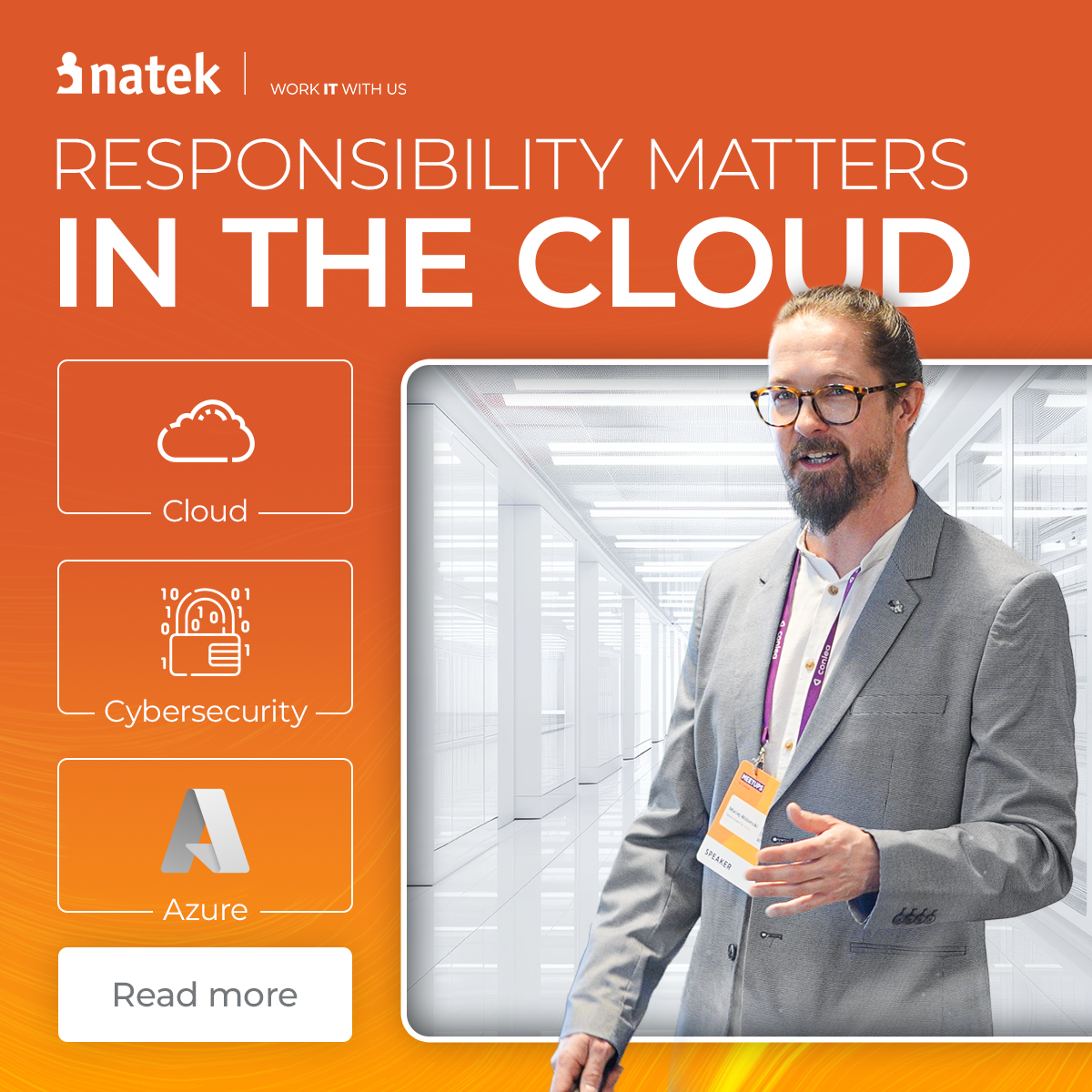Open any cloud bill after a busy release, and you’ll probably spot something puzzling: a spend that crept up without anyone noticing. It’s rarely one big mistake. More often, it’s a hundred tiny inefficiencies - an idle namespace here, a too-generous CPU request there, that add up over time. The idea behind a Zero Waste Cloud is simple: treat cloud capacity like a precious resource for your business value, and manage it with the same discipline you’d apply to product quality or reliability.
This article was written by Roman Łada-Grodzicki, Senior Lead Cloud Architect at NATEK, who brings extensive expertise in cloud computing and cloud migration to help implement new solutions and enhance existing processes for NATEK customers.

Cloud financial management - what's FinOps?
FinOps (Financial Operations) is part practice, part culture. It brings engineers, finance, and product together so decisions about cloud usage are grounded in timely data and shared accountability. Not “cut costs at all costs,” but “spend where it creates value, trim where it doesn’t.” In our line of work, teams that adopt this mindset tend to move faster, not slower - the feedback loop between usage and cost gets shorter, and decisions get better.
What are the TOP 3 traits that usually signal a healthy FinOps culture?
- Engineers see cost as a performance dimension they can influence.
- Finance gets near-real-time visibility rather than month-end surprises.
- Product weighs features not only by impact for users but also by footprint in the cloud.
Why Kubernetes changes the conversation about Cloud FinOps?
Kubernetes is brilliant at packing lots of workloads onto shared infrastructure. But it can also be, frankly, messy from a cost perspective. Containers are short-lived, autoscaling changes the shape of demand by the hour, and several teams might share the same nodes. Traditional “per server” tagging isn’t enough.
That’s why cost attribution in Kubernetes starts with metadata. If we can reliably answer “what is this workload?” and “who owns it?” then cost reports stop being abstract charts and start being actionable lists.
Traditional cloud cost management (which might rely on tagging whole Virtual Machines (VM) or tracking accounts/project usage) isn’t granular enough on its own for Kubernetes. This is where FinOps practices become vital for Kubernetes-based infrastructure:
- Dynamic, ephemeral resources: Containers can have lifespans of hours or even minutes, and they often share underlying VM instances. Costs need to be allocated correctly to each workload, which is non-trivial.
- Multi-tenant clusters: Multiple applications or teams might run on the same cluster nodes. Without careful tracking, you might not know which team’s service is racking up the bill or if a particular microservice is inefficient.
- Scale and automation: Kubernetes can scale workloads up and down automatically. While this is great for performance, it can also lead to surprise cost spikes if autoscaling isn’t tuned or if default settings over-provision resources.
Adopting FinOps: Labels as your virtual map of spend
Labels in Kubernetes are just key-value pairs, but used consistently they become a map that ties cloud charges back to applications and teams. Useful, everyday labels that make data driven decision-making easier, include:
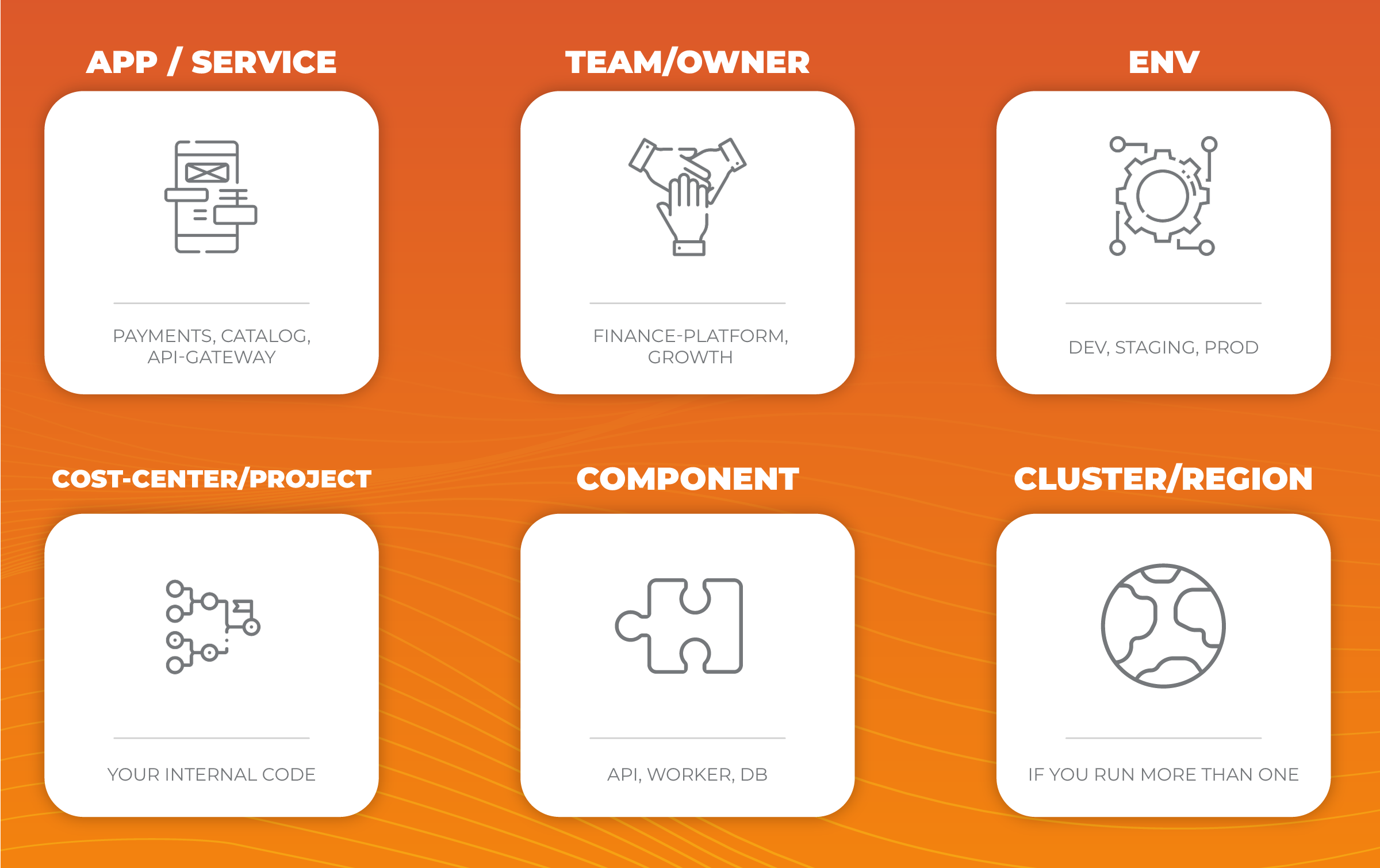
A quick example: if all pods for the payments service carry app=payments and team=finance-platform, your cost dashboard can show “payments in prod cost €X last week” with one click. That sounds obvious, but many clusters still run with sparse or inconsistent labels, which makes cost discussions frustratingly fuzzy.
How to make labeling hard to get wrong?
People are busy, and clear policies can help in avoiding the simplest mistakes. A few patterns our Team seen work well are for example to:
- Publish a short, opinionated label standard. Keep it to what you’ll actually use.
- Apply labels on creation, not in a cleanup sprint three months later.
- Enforce with admission controllers. OPA Gatekeeper or Kyverno can reject a deployment that’s missing team or env, or that uses an unknown value.
- Mirror K8s labels to cloud tags where possible so node and storage costs can be rolled up the same way.
Perfect consistency is unlikely. Good enough and enforced is usually plenty.
Where the savings hide: container-level
Although the labeling process can seem complicated at first, it'll get easier with every correctly marked container and cluster. As you go, small victories will compound in a real success. Below, you can see some easy to distinguish labels, that will immediately help you in keeping order in your cloud.
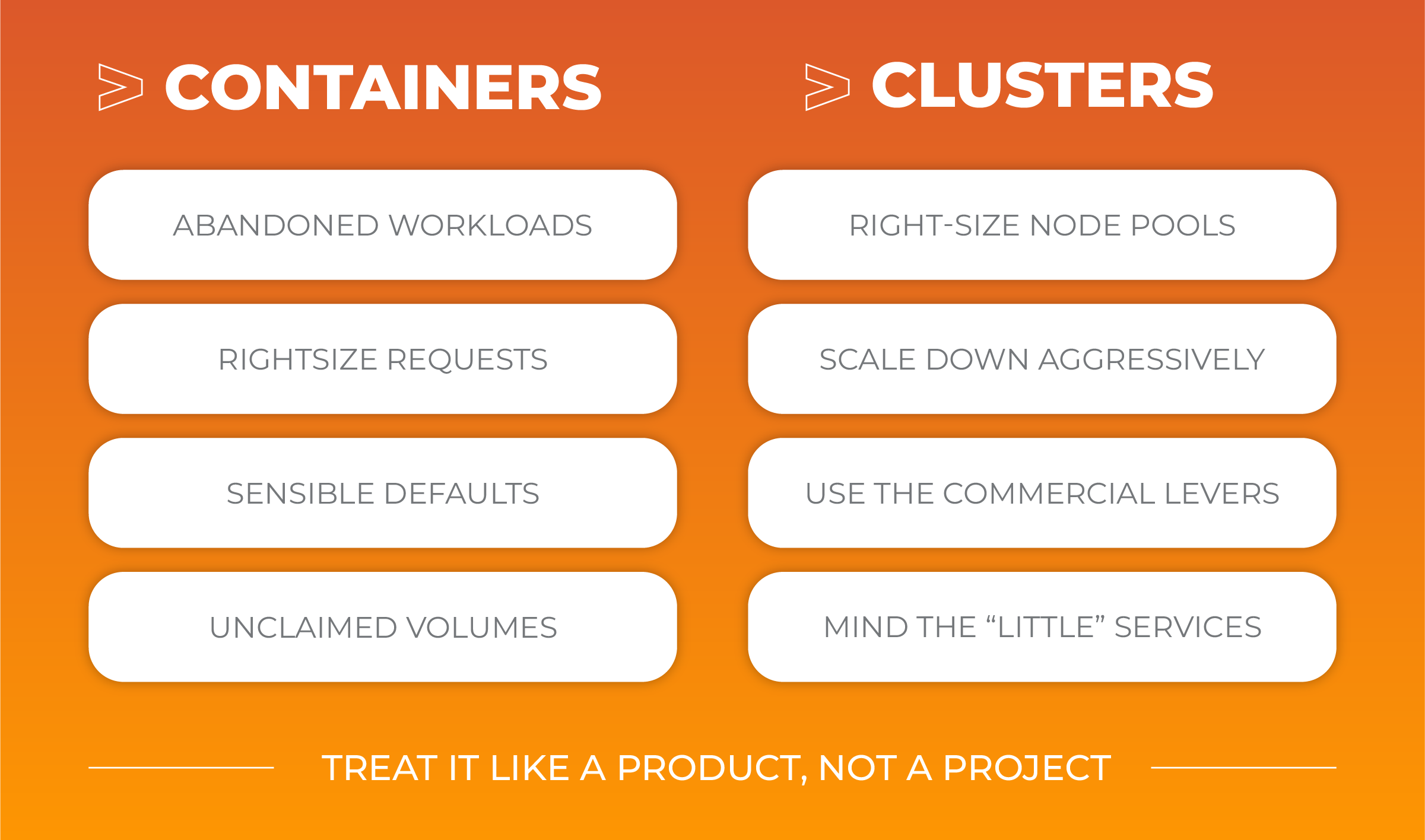
Optimization isn’t a one-off. Usage patterns shift, teams ship new features, and what was right-sized at the beginning of the year might be heavy by the end of it. The teams that keep improving usually work in simple loops:
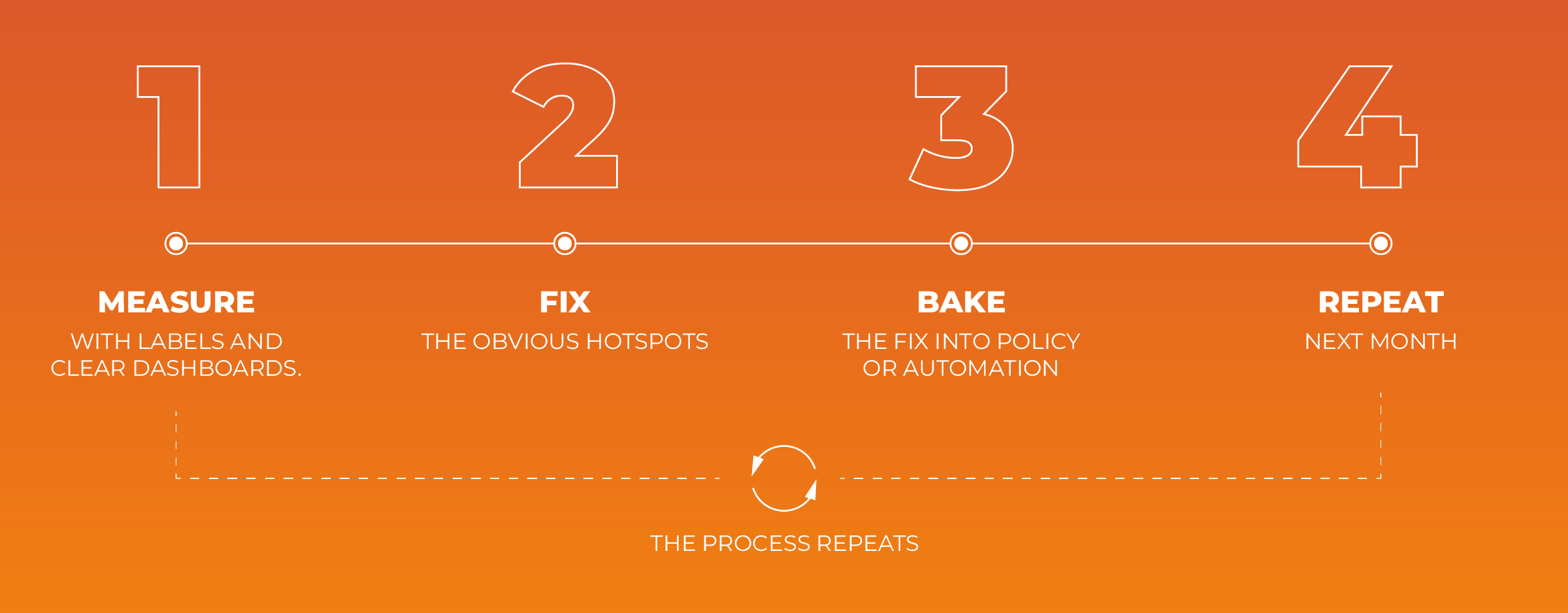
One small anecdote: a client added a single “no unlabeled deploys in prod” policy and a weekly 30-minute cleanup slot. Six weeks later, their cost allocation accuracy jumped, and the cleanup calendar was half empty - because there was less to clean up. Lesson? All recourse-consuming elements have to be labeled.
How NATEK can help your business with cloud costs?
Our Company uses decades of IT experience alongside deep cloud expertise to help Clients deploy these strategies within real-world environments, and with that, reach their business goals. NATEK provides organizations with complete support throughout their FinOps transformation process thanks to:
- Assessing and planning as our team works with your staff to evaluate present cloud usage patterns and develop immediate cost-saving opportunities as well as customized FinOps implementation strategies based on your business needs.
- Our experts at NATEK establish the proper foundations through Kubernetes labeling scheme configuration and policy engine setup and cost dashboard and alert system implementation. Our Team enables organizations to integrate open-source FinOps tools from the CNCF landscape and commercial platforms to achieve complete visibility and control.
- NATEK's Cloud Architects and FinOps Consultants help organizations execute rightsizing exercises and improve their CI/CD for cost-aware deployments, while establishing processes for regular cost reviews and game days to hunt for savings. Our Team implements established methodologies to unite development teams with operations teams and finance stakeholders for coordinated efforts.
- NATEK Team provides guidance for implementing AI-based solutions that enhance your FinOps practices through automated anomaly detection and intelligent scheduling, as well as real-time resource allocation prediction using machine learning models.
Our Team delivers training programs and workshops to establish FinOps awareness and skills throughout your organization. NATEK helps other businesses spread FinOps principles to develop a culture where every team member understands accountability, shared responsibility and efficiency. The development of a self-sustaining culture leads to FinOps becoming an integral part of your cloud operations DNA.
Final thoughts on FinOps approach
A Zero Waste Cloud isn’t perfection - some slack is healthy. The point is to make waste the exception rather than the default. Clear labels, small steady fixes, and a culture that treats cost as a shared concern usually get you most of the way there. The rest is iteration.
If you are looking for a professional Team of Experts with years of experience in providing cloud services and cost optimization solutions to Fortune Global 500 companies around the world, do not hesitate to contact our NATEK Sales Prospection Team Lead Andrzej Osman at andrzej.osman@natek.eu or fill out our Contact form to begin our collaboration, #growITwithus and reach for success!
